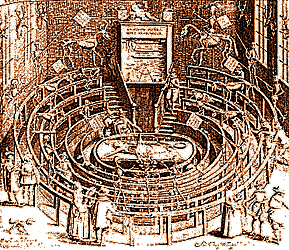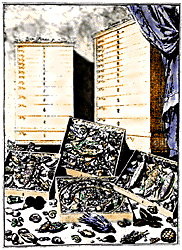
CONTEMPORARY CURIOSITY
The roots of modern university collecting habits lie in the sixteenth-century curiosity cabinet. However, it would seem we have come a very long way in our ability to analyze the natural world, to understand its organizing principles and to arrive at truths concerning physical realities. To a great extent this is true; using new technologies we probe into regions or scales of time and space, from the sub-atomic to the cosmic, unimaginable in the sixteenth century.
 The second part of our exhibition, a similar collection of objects organized in
accordance with the ordering principles of the contemporary university, reflects
the shift from a sixteenth-century paradigm to the modern one. The primary
changes revealed by a comparison of the two spaces are: a division of knowledge
into separate disciplines, each with its own methodology; the sixteenth-century
"horizontal" chain of qualitative comparison replaced by the modern "vertical,"
narrowly focused, quantitative analysis; and a modern tendency to view categories
as naturally determined, rational and intrinsic to the physical world. In the
modern collection, the typical example, the defining norm, becomes the object of
knowledge, revealing the essential qualities of a particular category.
The second part of our exhibition, a similar collection of objects organized in
accordance with the ordering principles of the contemporary university, reflects
the shift from a sixteenth-century paradigm to the modern one. The primary
changes revealed by a comparison of the two spaces are: a division of knowledge
into separate disciplines, each with its own methodology; the sixteenth-century
"horizontal" chain of qualitative comparison replaced by the modern "vertical,"
narrowly focused, quantitative analysis; and a modern tendency to view categories
as naturally determined, rational and intrinsic to the physical world. In the
modern collection, the typical example, the defining norm, becomes the object of
knowledge, revealing the essential qualities of a particular category.
Yet many of our categories are every bit as arbitrary now as they were then. Indeed, all the categories in the second part of the exhibition, from the disciplinary divisions, to comparisons of form, measurements of space, or assemblages of tools and mementos, would have been perfectly appropriate in any curiosity cabinet. Perhaps more importantly, we still rely upon physical artifacts to gather knowledge and to transmit it to others, even if some of our tools and concepts have changed dramatically. We collect specimens, we compare analogous structures, we seek after similarities and differences. However abstract or theoretical our approach, however much we rely on computers, what we all ultimately seek to explain are the wonders and mysteries of the world around us. Both in the totality of its collections, and within its separate divisions, the university is a series of microcosms which reflect our unbridled curiosity in the world around us.
 The room in which our exhibition of the modern collecting paradigm was housed was
a large, white, well-lit modernist box. Category headings, affixed to the wall in
large letters, organized the objects into sections entitled: The University Divided into Four, The
World Made VisibleComparing Form and Structure, Measuring Time and Space, Tools and
Instruments, and Commemoration. These headings,
pedagogical in tone, directed the viewer's interpretation of the objects even
before he or she had a chance to study them. Wall labels were used extensively to
explain the function of the objects and the parameters of the categories. The
generous spacing between objects encouraged the viewer to consider them as
singular items, or as a part of a small group of functionally similar things.
Legibility, functionalism and rational clarity are the primary aims of this sort
of display strategy, common to most modern museums.
The room in which our exhibition of the modern collecting paradigm was housed was
a large, white, well-lit modernist box. Category headings, affixed to the wall in
large letters, organized the objects into sections entitled: The University Divided into Four, The
World Made VisibleComparing Form and Structure, Measuring Time and Space, Tools and
Instruments, and Commemoration. These headings,
pedagogical in tone, directed the viewer's interpretation of the objects even
before he or she had a chance to study them. Wall labels were used extensively to
explain the function of the objects and the parameters of the categories. The
generous spacing between objects encouraged the viewer to consider them as
singular items, or as a part of a small group of functionally similar things.
Legibility, functionalism and rational clarity are the primary aims of this sort
of display strategy, common to most modern museums.
 |
{Essays} {Gallery} {Microcosms} |
 |